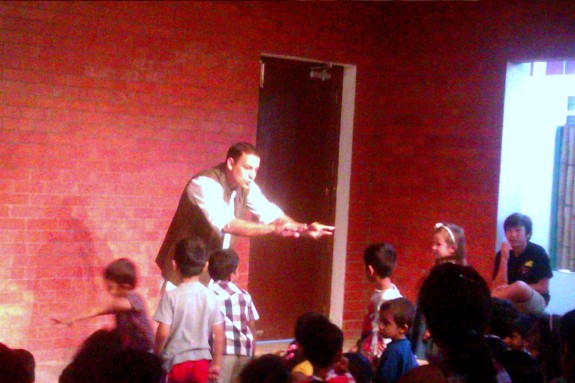Bandish Bandits seems to have it all. I almost imagine the writers Anand Tiwari & Amritpal Singh Bindra mixing everything in the right proportion in a beaker to magically create this web series (like how a scientist created Powerpuff Girls).
Rajasthan is stunning as a location.

The whole environment – culture, colours, music, architecture, even the town’s small lanes successfully send the viewer mentally to that gorgeous Indian state. Rajasthan sets up the perfect backdrop to the story & plays an important role in every scene. I have fallen in love with this vibrant state!
Story’s basic plot seems pretty similar to Katyar Kaljat Ghusli however Bandish Bandits characters are more real.

Katyar was more of black & white – Pandit Bhanuprasad all good & Khansaheb all bad but Bandish Bandits has given real shades to the characters.
Pandit Radhemohan Rathod (Naseeruddin Shah) is a master of his art but is egoistic, sometimes unnecessarily strict & can make really bad decisions too. Digvijay Rathod (Atul Kulkarni) wants to destroy Panditji; but at the core of his heart, he is simply an abandoned son longing for the love & acceptance of his father.
While Panditji is all about perfection in art & life, Radhe’s father Rajendra & uncle Devendra (Rajesh Tailang & Amit Mistry) lend the necessary practicality to Radhe’s life. They balance the abstract with the concrete for Radhe. They are the unsung heroes in the final episode, I believe.
Mohini (Sheeba Chaddha) is that typical Indian mother who shares brilliant secrets of the art with her child; later of course we come to know that she herself is a master of the art. I loved her character. She is the one who finally trains Radhe after Panditji bows out due to his ego. The way she trains Radhe reminded me of The Karate Kid. She teaches Radhe to find music in the most mundane activities; that everything in this universe has its own rhythm & timbre.
The final 2 episodes are going to be my favourite where the whole family comes together & they all become a formidable force to save their gharana.
Kabir (Rahul Kumar) is Radhe’s best friend & Arghya (Kunaal Roy Kapur) is Tamanna’s manager. Both add humour & comfort during life’s tough situations. Every movie/TV series (& every person alive) should have at least 1 such character/person. This friend who unabashedly gives gaalis but is the only person available in need… & yet these characters NEVER get much limelight. The actors who play these roles should be celebrated as much as the lead actors.
Frankly, the love story is not as important as the intensity of acting genius by Naseeruddin Shah, Atul Kulkarni & Sheeba Chaddha & the layers added by all other characters.
Similarities are in the differences and they are always in hand-in-hand.
I have found numerous parallels in the story.
There is an episode where Tamanna tells Radhe that his notes are perfect but he lacks the emotion. The same day Panditji tells Radhe that ‘bhaav’ is missing in his piece & it is the job of an artist to make the listeners feel, not just listen.
In the 8th episode, Panditji loses Radhe to Western pop music (he discovers Radhe’s secret collaboration) & Tamanna loses Radhe to classical music (Radhe doesn’t turn up at her concert). The situation is a complex one & the build-up to it is very engaging. Looking at it from a third person’s perspective, I realize that life is beautiful in all its mess when seen objectively.
I found a life lesson too.
I think I saw a recurring theme in Bandish Bandits. When we gain something, we also have to be prepared to let it go. (Or maybe we should not hold on to anything in the first place.)
The doctor reveals that Panditji’s ear is deteriorating; Panditji is losing his hearing ability. In a flash, Panditji realizes that he is going to lose what he pursued all his life. Naseeruddin Shah portrays that disappointment with his mere expressions… such brilliance.
After all the hard work, Tamanna gets to know that her idol Queen Ellie wants to perform with Radhe & not her. Performing with Queen Ellie was something that Tamanna dreamed of all her life. And while objectively Queen Ellie’s decision is justified as Radhe is technically a better singer, Tamanna has difficulty accepting it because she is so attached to that dream.
Radhe’s uncle Devendra sells the ownership of his creation – a musical instrument ‘Devlin’ to some foreigners to save his ancestral home. That letting go is an instantaneous decision but must be so painful. After he gets the money, he sheds some tears & quickly wipes those off & I could feel my heart breaking. The scene is fast paced but Amit Mistry plays it to the tee.
Finally, to make all this complexity relatable, there’s a cliche romance with new age lingo & speed in love (& sex).

This is actually an excellent strategy to make sure the young generation watches & enjoys; but more importantly, notices the beauty of Indian classical music. I know for sure that without this very cliche romantic story line, the young gen wouldn’t take much interest in the series. The love story has some essence of Abhimaan to it (partner who is a new entrant unknowingly stealing the limelight from the partner who was the star in the first place).
Classical meets Contemporary in love as well as music.

I would be a fool if I didn’t mention Shankar Ehsaan Loy’s musical genius. I don’t have words to describe their effort, the attention to detail & research they must have done to achieve the music of Bandish Bandits. This is the #1 reason I kept watching till the end. I DIDNT WANT TO MISS THE MUSIC! It would be a crime to miss it. The songs & Raag renditions are obviously worth a mention, but more than anything, Radhe’s practice & training sessions with Panditji & later his mother were quite an experience as you will get to hear the minutest details of Indian music. (Love the detail of Panditji’s finger counting for Radhe’s aavartan practice.)
This is (almost) a stream of consciousness post.
I didn’t have to “think” for the first draft of what I have written here; the thoughts literally poured in without any effort! When something is so powerful to generate such stream of thought, it should be acknowledged & appreciated. So here’s a big thank you to the writers & the team for giving us something so precious in a long long time! Take a bow!
~ Shubhada


































